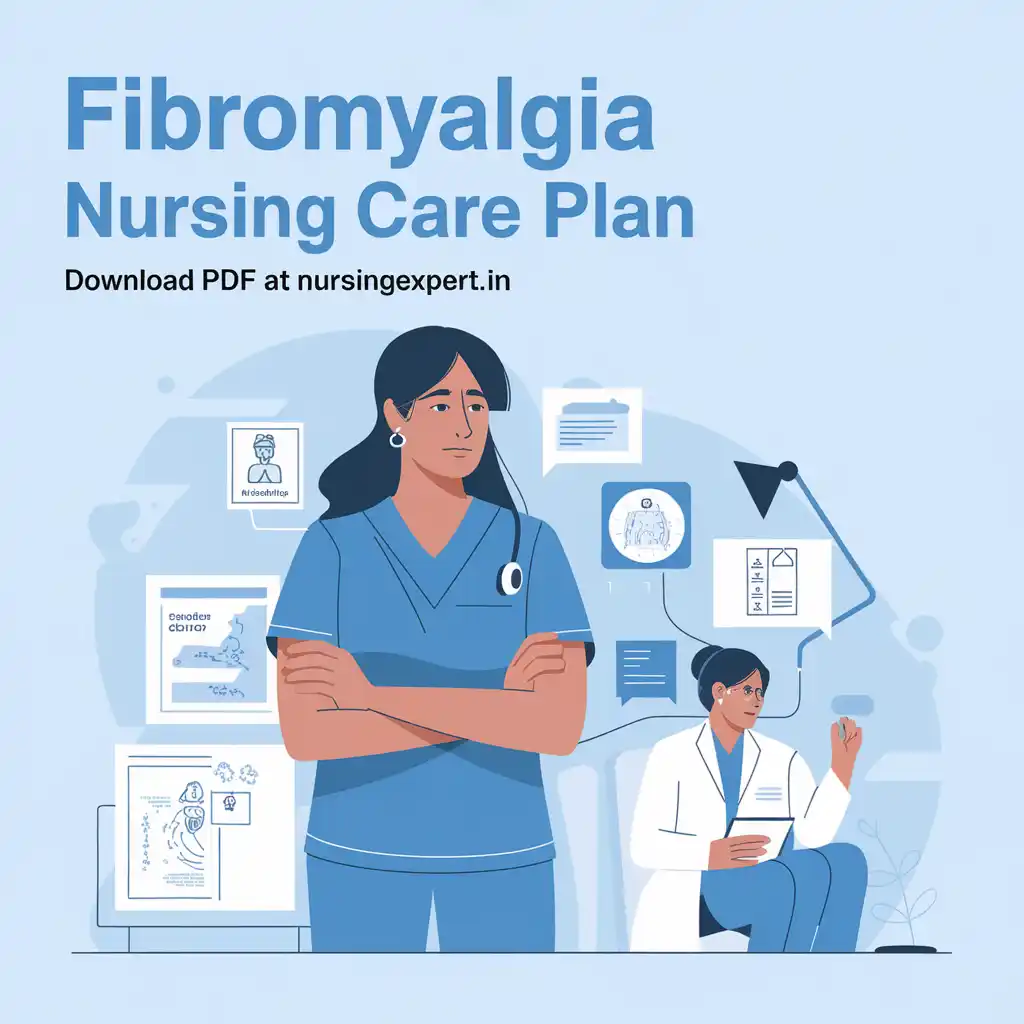Nursing Care Plan for Fibromyalgia: Fibromyalgia is a chronic disorder characterized by widespread musculoskeletal pain, fatigue, and tenderness in localized areas. It can significantly impact a patient’s daily activities and quality of life. For nursing students and professionals, having clear and practical nursing care plans is essential for managing fibromyalgia effectively. This guide presents 5 evidence-based nursing care plans designed to address pain, fatigue, sleep disturbances, and emotional stress associated with fibromyalgia. A sample 7-column care plan template is included, along with a downloadable PDF resource from NursingExpert.in.
Thank you for reading this post, don't forget to subscribe!
What is Fibromyalgia?
Fibromyalgia is a long-term condition that causes widespread pain and tenderness throughout the body. Patients may also experience fatigue, sleep disturbances, and emotional distress. Although its exact cause is not known, fibromyalgia is believed to involve abnormal pain processing in the central nervous system.


Causes and Triggers of Fibromyalgia
While the exact cause of fibromyalgia remains unclear, several factors may contribute:
- Genetic Predisposition: A family history of fibromyalgia or other chronic pain conditions.
- Infections: Certain infections may trigger the onset of fibromyalgia.
- Physical or Emotional Trauma: Past injuries or severe stress can contribute to the development of the condition.
- Sleep Disorders: Poor sleep quality can worsen fibromyalgia symptoms.
Symptoms of Fibromyalgia
Common symptoms include:
- Widespread body pain and tenderness
- Chronic fatigue and low energy levels
- Sleep disturbances, including non-restorative sleep
- Cognitive difficulties (“fibro fog”) such as memory problems and poor concentration
- Mood disturbances, such as anxiety and depression
- Headaches and irritable bowel syndrome (IBS)
Nursing Care Plans & Management
A structured nursing care plan is crucial for managing fibromyalgia effectively. Key priorities include:
Nursing Problem Priorities
- Chronic Pain and Discomfort: Managing widespread pain.
- Fatigue and Sleep Disturbances: Addressing lack of restorative sleep.
- Emotional Stress: Coping with anxiety and depression.
- Ineffective Coping: Challenges in dealing with chronic illness.
- Knowledge Deficit: Patient and family may not fully understand the condition.
Nursing Assessment and Diagnostic Findings
- Pain Assessment: Use a standardized pain scale to measure pain intensity.
- Sleep Evaluation: Assess sleep patterns and quality.
- Vital Signs: Monitor blood pressure, heart rate, and temperature.
- Patient History: Review previous pain episodes, triggering factors, and impact on daily activities.
- Physical Examination: Identify tender points and areas of pain.
- Psychological Evaluation: Assess for signs of anxiety and depression.
Nursing Goals
Short-Term Goals
- Pain Relief: Reduce pain levels to ≤3/10 within 2 hours after initiating interventions.
- Improve Sleep Quality: Enhance sleep quality so that the patient reports at least 6 hours of restorative sleep within 24–48 hours.
- Stabilize Vital Signs: Maintain stable vital signs during pain episodes.
- Reduce Emotional Stress: Decrease anxiety and improve mood within 24 hours.
- Enhance Patient Education: Ensure that the patient and family understand the condition and management strategies within 24 hours.
Long-Term Goals
- Improve Daily Functioning: Enable the patient to resume normal daily activities with reduced pain and fatigue.
- Sustain Pain Management: Achieve consistent pain control through ongoing interventions.
- Promote Emotional Well-Being: Enhance coping strategies and reduce anxiety and depression.
- Prevent Symptom Exacerbation: Educate the patient on trigger avoidance and lifestyle modifications.
- Maintain Knowledge: Ensure continuous adherence to the care plan and follow-up appointments.
Nursing Interventions and Actions
- Pain Management
- Interventions:
- Administer prescribed analgesics and muscle relaxants.
- Use non-pharmacologic methods such as warm compresses and gentle massage.
- Encourage rest in a comfortable position.
- Rationale: Reduces pain intensity and improves overall comfort.
- Interventions:
- Enhancing Sleep Quality
- Interventions:
- Create a calm, dark, and quiet environment for sleep.
- Educate the patient on good sleep hygiene practices.
- Administer sleep aids if prescribed.
- Rationale: Improves sleep quality, which is essential for overall recovery.
- Interventions:
- Managing Fatigue
- Interventions:
- Encourage energy conservation techniques and scheduled rest periods.
- Assist with light physical activities as tolerated to prevent deconditioning.
- Rationale: Balances activity and rest to reduce fatigue and enhance energy levels.
- Interventions:
- Providing Emotional Support
- Interventions:
- Offer empathetic listening and validate the patient’s feelings.
- Provide referrals for counseling or support groups if needed.
- Use relaxation techniques such as deep breathing exercises.
- Rationale: Helps reduce anxiety and depression associated with chronic pain.
- Interventions:
- Patient and Family Education
- Interventions:
- Explain fibromyalgia, its symptoms, and management strategies in simple language.
- Provide written materials on dietary modifications, exercise, and stress management.
- Use the teach-back method to confirm understanding.
- Rationale: Informed patients are more likely to follow treatment plans and manage their condition effectively.
- Interventions:
Sample Nursing Care Plan for Fibromyalgia
| Nursing Diagnosis | Patient Goals/Expected Outcomes | Assessment Data | Nursing Interventions | Rationale | Evaluation | Documentation/Follow-Up |
|---|---|---|---|---|---|---|
| Acute Pain | Reduce headache and body pain to ≤3/10 within 2 hours | Patient reports pain score of 6/10; tender points on examination | Administer prescribed analgesics; use warm compresses; encourage rest and relaxation techniques | Reduces pain intensity and improves comfort | Pain score decreases; patient reports reduced discomfort | Record pain scores and interventions |
| Sleep Pattern Disturbance | Achieve at least 6 hours of restful sleep within 24–48 hours | Patient reports poor sleep quality and frequent awakenings | Provide a dark, quiet environment; administer sleep aids if needed; educate on sleep hygiene practices | Improves sleep quality and promotes recovery | Patient reports improved sleep; fewer awakenings | Document sleep patterns and intervention outcomes |
| Fatigue | Enhance energy levels and reduce fatigue within 48 hours | Patient reports excessive tiredness; low energy levels | Encourage energy conservation techniques; assist with light physical activities; schedule rest periods | Balances activity and rest to boost energy | Patient demonstrates increased energy and participation | Record activity levels and patient feedback |
| Knowledge Deficit | Patient and family will accurately explain the care plan within 24 hours | Family expresses uncertainty about managing fibromyalgia | Provide clear, written and verbal education; use teach-back method; distribute educational pamphlets | Empowers patients and families for better self-care | Family demonstrates understanding; adheres to guidelines | Document educational sessions and verify comprehension |
| Anxiety | Reduce patient and family anxiety within 24 hours | Patient and family show signs of stress and worry | Offer emotional support; use relaxation techniques; provide clear explanations about the care plan | Reduces emotional distress and promotes a supportive environment | Anxiety decreases; positive feedback received | Document emotional support sessions and counseling |
Downloadable PDF Resource
For your convenience, a detailed Nursing Care Plan for Fibromyalgia is available as a downloadable PDF.
Download the Fibromyalgia Nursing Care Plan PDF Here at NursingExpert.in
Frequently Asked Questions (FAQs)
What is fibromyalgia?
Fibromyalgia is a chronic condition that causes widespread pain, fatigue, and tender points in the muscles and soft tissues.
What are common symptoms of fibromyalgia?
Symptoms include severe pain, fatigue, sleep disturbances, and mood changes such as anxiety and depression.
How is fibromyalgia diagnosed?
Diagnosis is made based on patient history, physical examination, and pain assessments, as there is no specific laboratory test for it.
What are the key nursing interventions for fibromyalgia?
Interventions include pain management, sleep enhancement, fatigue management, emotional support, and patient education.
Where can I download the PDF for nursing care plan?
You can download the free PDF resource from NursingExpert.in.
Conclusion
Fibromyalgia can significantly affect a patient’s quality of life, but a well-structured nursing care plan can help manage pain, improve sleep, and reduce emotional distress. By following these 5 nursing care plans, Indian nursing students and professionals can provide compassionate, evidence-based care to patients with fibromyalgia. Use this guide and the downloadable PDF from NursingExpert.in to enhance your clinical practice and support long-term patient well-being.
References and Sources
- National Institutes of Health (NIH). (2023). Fibromyalgia: Overview and Management. Retrieved from https://www.nih.gov
- Centers for Disease Control and Prevention (CDC). (2023). Fibromyalgia Information. Retrieved from https://www.cdc.gov
- American Nurses Association (ANA). (2022). Standards for Nursing Practice. Retrieved from https://www.nursingworld.org
- MedlinePlus. (2023). Fibromyalgia. Retrieved from https://medlineplus.gov
- World Health Organization (WHO). (2023). Guidelines on Chronic Pain Management. Retrieved from https://www.who.int


